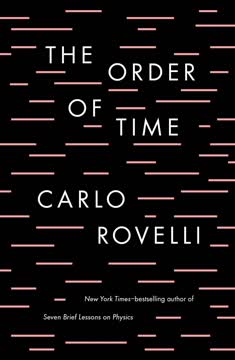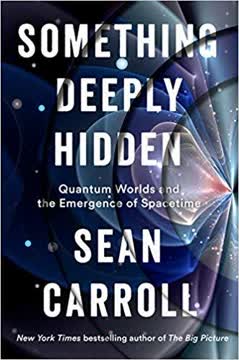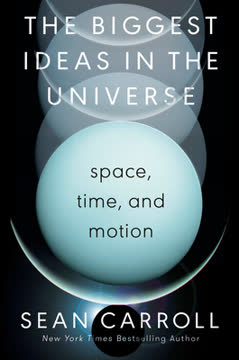Key Takeaways
1. Quantum theory challenges our intuition but accurately describes reality
Quantum theory is perhaps the prime example of the infinitely esoteric becoming the profoundly useful.
Counterintuitive yet precise. Quantum theory defies common sense but provides unparalleled accuracy in describing the behavior of subatomic particles. It explains phenomena that classical physics cannot, such as the stability of atoms and the discrete emission spectra of elements.
Practical applications abound. Despite its abstract nature, quantum theory has led to numerous technological breakthroughs:
- Transistors and modern electronics
- Lasers and fiber optic communications
- Magnetic Resonance Imaging (MRI) in medicine
- Cryptography and quantum computing
The theory's success in both explaining fundamental physics and enabling practical applications underscores its importance in modern science and technology.
2. Particles can be in multiple places simultaneously, leading to wave-like behavior
Everything that can happen does happen.
Superposition principle. In quantum mechanics, particles exist in a state of superposition, occupying multiple positions simultaneously until observed. This fundamental principle explains the famous double-slit experiment, where individual particles create an interference pattern as if they were waves.
Wave-particle duality. The dual nature of quantum entities as both particles and waves is encapsulated in de Broglie's equation: λ = h/p
- λ: wavelength
- h: Planck's constant
- p: momentum
This relationship bridges the particle and wave descriptions, showing how quantum objects can exhibit properties of both. The wave nature of particles explains phenomena like electron diffraction and the quantum tunneling effect, which is crucial for technologies like scanning tunneling microscopes and flash memory devices.
3. The Uncertainty Principle limits our knowledge of particle properties
The more precisely you know the position of a particle at some instant, the less well you know how fast it is moving and therefore where it will be sometime later.
Fundamental limitation. Heisenberg's Uncertainty Principle states that certain pairs of physical properties, such as position and momentum, cannot be simultaneously measured with arbitrary precision. This is not due to measurement limitations but a fundamental aspect of quantum systems.
Implications:
- Limits on measurement accuracy
- Explains quantum tunneling
- Leads to quantum fluctuations in vacuum
- Impacts the stability of atoms
The Uncertainty Principle has far-reaching consequences, from the behavior of electrons in atoms to the nature of the quantum vacuum. It challenges the classical notion of determinism and introduces an inherent element of probability in quantum mechanics.
4. Quantum waves explain atomic structure and spectral lines
The symmetric wave is the one with the lower energy.
Standing waves in atoms. Electrons in atoms behave like standing waves, with discrete energy levels corresponding to different wave patterns. This quantum mechanical model explains:
- Stability of atoms
- Discrete emission and absorption spectra
- Chemical properties of elements
Bohr model to quantum mechanics. The transition from Bohr's planetary model to the quantum mechanical description of atoms resolved many inconsistencies:
- Explains why electrons don't spiral into the nucleus
- Accounts for the specific spectral lines of elements
- Provides a framework for understanding chemical bonding
The quantum mechanical model of atoms forms the basis for understanding the periodic table, chemical reactions, and the behavior of materials at the atomic scale.
5. The Pauli Exclusion Principle governs electron behavior and enables atomic stability
Electrons avoid each other.
Fundamental rule for fermions. The Pauli Exclusion Principle states that no two identical fermions (particles with half-integer spin) can occupy the same quantum state simultaneously. This principle has profound consequences:
- Determines electron configurations in atoms
- Explains the stability of matter
- Underlies the periodic table of elements
Implications for matter:
- Prevents atoms from collapsing
- Enables the diversity of chemical elements
- Explains the structure of white dwarf stars
The Pauli Exclusion Principle is crucial for understanding the structure of matter from the atomic scale to astrophysical objects. It explains why matter is "solid" despite being mostly empty space at the atomic level.
6. Quantum mechanics underpins chemical bonding and material properties
The Universe is built from particles that move around and interact according to a handful of hopping and branching rules.
Covalent bonding. Quantum mechanics explains chemical bonding through the sharing of electrons between atoms. This understanding is crucial for:
- Predicting molecular structures
- Explaining chemical reactivity
- Designing new materials
Band theory of solids. Quantum mechanics provides a framework for understanding the electronic properties of materials:
- Explains conductors, insulators, and semiconductors
- Enables the design of electronic devices
- Forms the basis for understanding superconductivity
The quantum mechanical description of electrons in materials has led to numerous technological advancements, from the development of new alloys to the creation of advanced electronic components.
7. Particle interactions are governed by simple rules with profound consequences
QED is the theory that explains how electrically charged particles, like electrons, interact with each other and with particles of light (photons).
Quantum Electrodynamics (QED). This theory describes the interactions between charged particles and photons using simple rules:
- Particles can emit or absorb photons
- Interactions are represented by Feynman diagrams
- Probability amplitudes are calculated for each possible interaction
Applications and implications:
- Explains atomic spectra with unprecedented accuracy
- Accounts for the Lamb shift in hydrogen atoms
- Provides a framework for understanding all electromagnetic phenomena
QED serves as a model for other quantum field theories, such as those describing the weak and strong nuclear forces. Its success in explaining electromagnetic interactions with extreme precision has made it one of the most well-tested theories in physics.
8. The quantum vacuum is a dynamic realm filled with virtual particles
Quantum physics implies that there is no such thing as empty space.
Vacuum fluctuations. The quantum vacuum is far from empty; it's a seething sea of virtual particles constantly popping in and out of existence:
- Explains the Casimir effect
- Contributes to the Lamb shift
- May play a role in dark energy
Higgs field. The quantum vacuum is thought to be permeated by the Higgs field:
- Gives mass to fundamental particles
- Results from a phase transition in the early universe
- Predicts the existence of the Higgs boson
Understanding the quantum vacuum is crucial for modern particle physics and cosmology. It challenges our classical notion of "empty space" and has profound implications for our understanding of the universe's structure and evolution.
9. Quantum theory enables technological marvels like transistors
The transistor is perhaps the most important invention of the last 100 years.
Semiconductor physics. Quantum mechanics explains the behavior of electrons in semiconductors, enabling the development of transistors:
- Explains conduction bands and valence bands
- Accounts for the properties of p-n junctions
- Enables precise control of electron flow
Technological impact:
- Basis for modern electronics and computing
- Enables miniaturization of electronic devices
- Underpins the information technology revolution
The transistor, a direct application of quantum mechanics, has transformed nearly every aspect of modern life. Its development has led to the information age, revolutionizing communication, computation, and countless other fields.
10. The death of stars demonstrates the far-reaching implications of quantum mechanics
The Chandrasekhar mass is, rather astonishingly, obtained by contemplating two masses, one the size of a grain of sand and the other the mass of a single proton.
White dwarf stars. Quantum mechanics explains the stability of white dwarf stars against gravitational collapse:
- Electron degeneracy pressure, a consequence of the Pauli Exclusion Principle, supports the star
- The Chandrasekhar limit (~1.4 solar masses) sets the maximum mass for a stable white dwarf
Implications:
- Links quantum mechanics to astrophysics
- Demonstrates the universal applicability of quantum principles
- Helps explain the life cycles of stars and the production of heavy elements
The ability of quantum mechanics to explain phenomena from the subatomic scale to the astronomical scale highlights its fundamental nature. The Chandrasekhar limit, derived from quantum mechanical principles, plays a crucial role in our understanding of stellar evolution and the chemical enrichment of the universe.
Last updated:
FAQ
What's The Quantum Universe about?
- Exploration of Quantum Mechanics: The Quantum Universe by Brian Cox explores the principles of quantum mechanics, a fundamental pillar of modern physics alongside relativity.
- Demystifying Complex Concepts: It aims to make complex ideas like wave-particle duality and the uncertainty principle accessible to a general audience.
- Interconnectedness of Science: The book highlights how quantum theory underpins various phenomena, from atomic behavior to modern technology.
Why should I read The Quantum Universe?
- Engaging and Informative: Written by renowned physicist Brian Cox, the book presents intricate scientific concepts in an engaging manner, suitable for both novices and those with some science background.
- Real-World Applications: It connects theoretical physics to practical applications, illustrating quantum mechanics' influence on everyday life and technological advancements.
- Curiosity-Driven Exploration: The book encourages readers to embrace their curiosity about the universe, emphasizing the importance of fundamental research in shaping our understanding of reality.
What are the key takeaways of The Quantum Universe?
- Quantum Mechanics is Fundamental: The book asserts that quantum mechanics is essential for understanding the natural world, describing the behavior of matter's smallest building blocks.
- Uncertainty Principle Explained: Heisenberg’s Uncertainty Principle is a central theme, illustrating the trade-off between knowing a particle's position and momentum.
- Interconnected Universe: It emphasizes that all particles are interconnected, influencing each other in ways that challenge classical notions of separateness.
How does The Quantum Universe explain wave-particle duality?
- Dual Nature of Particles: The book discusses how particles, like electrons, can behave both as particles and as waves, depending on the experimental setup.
- Double-Slit Experiment: It uses the double-slit experiment to illustrate this concept, where electrons create an interference pattern, suggesting wave-like behavior.
- Quantum Superposition: The authors explain that particles exist in a state of superposition, meaning they can be in multiple states or locations simultaneously until measured.
What is the Uncertainty Principle in The Quantum Universe?
- Core Concept: The Uncertainty Principle states a fundamental limit to how precisely we can know both the position and momentum of a particle simultaneously.
- Mathematical Representation: It is expressed as ΔxΔp ∼ h, where Δx is the uncertainty in position, Δp is the uncertainty in momentum, and h is Planck's constant.
- Implications for Measurement: This principle highlights that measuring one property with high precision will inherently increase the uncertainty in the other.
What is the Pauli Exclusion Principle in The Quantum Universe?
- Definition of the Principle: The Pauli Exclusion Principle states that no two identical fermions can occupy the same quantum state simultaneously.
- Implications for Electrons: It explains why electrons in an atom occupy different energy levels and arrange themselves in shells around the nucleus.
- Real-World Consequences: The principle is crucial for the stability of matter, preventing electrons from collapsing into the nucleus and allowing for complex structures.
What role does the Higgs boson play in The Quantum Universe?
- Mass Generation: The Higgs boson is central to the Higgs mechanism, explaining how particles acquire mass through interactions with the Higgs field.
- Search for the Higgs: The book discusses the significance of the search for the Higgs boson at the Large Hadron Collider, emphasizing its importance in confirming the Standard Model.
- Implications for Understanding the Universe: Understanding the Higgs boson has profound implications for our comprehension of the universe's structure and fundamental forces.
How does The Quantum Universe relate quantum mechanics to everyday life?
- Impact on Technology: The authors illustrate how quantum mechanics underpins modern technology, including semiconductors and transistors, essential for computers and electronic devices.
- Understanding Natural Phenomena: The book explains how quantum principles govern natural phenomena, influencing everything from chemical reactions to material properties.
- Encouraging Curiosity: By relating complex scientific concepts to everyday experiences, the authors inspire readers to explore and question the nature of reality.
What is the significance of Planck's constant in The Quantum Universe?
- Fundamental Constant: Planck's constant (h) relates the energy of a photon to its frequency, bridging wave and particle descriptions.
- Quantization of Energy: It signifies that energy is quantized, meaning it can only take on discrete values, crucial for understanding atomic processes.
- Role in Uncertainty Principle: Planck's constant appears in the Uncertainty Principle, emphasizing its importance in defining measurement limits in quantum mechanics.
How does The Quantum Universe address the concept of empty space?
- Not Truly Empty: The book argues that empty space is filled with quantum fluctuations and virtual particles that pop in and out of existence.
- Higgs Field Presence: It discusses the Higgs field as a fundamental aspect of the vacuum, providing mass to particles and influencing their behavior.
- Implications for Physics: The idea that empty space is teeming with activity has profound implications for understanding forces and particle behavior.
What are the best quotes from The Quantum Universe and what do they mean?
- "The more we understand...": This quote reflects the authors' view that fundamental physics principles reveal simplicity in the universe's complexity.
- "Quantum theory is perhaps...": Highlights how abstract quantum concepts have led to significant technological advancements and practical applications.
- "The job of a theory...": Emphasizes the scientific method's reliance on testable predictions, underscoring the importance of empirical evidence.
What is the significance of Feynman diagrams in The Quantum Universe?
- Visual Representation of Interactions: Feynman diagrams provide a graphical way to represent particle interactions, making complex calculations more manageable.
- Calculating Probabilities: They help physicists calculate the probabilities of various outcomes in particle interactions by summing contributions from different paths.
- Understanding Quantum Processes: Feynman diagrams allow for a clearer understanding of quantum processes, such as scattering and decay, by visualizing particle interactions.
Review Summary
The Quantum Universe receives mixed reviews. Many praise its accessibility and engaging explanations of complex quantum concepts, particularly the Pauli exclusion principle. However, some find the "clock" analogy confusing and overused. Readers appreciate Cox's ability to convey difficult ideas without heavy mathematics, though some argue it's still too complex for laypeople. The book is commended for its novel approach to quantum mechanics, but criticized for potentially overwhelming readers new to the subject. Overall, it's seen as a valuable resource for those with some prior knowledge of quantum physics.
Similar Books
Download PDF
Download EPUB
.epub digital book format is ideal for reading ebooks on phones, tablets, and e-readers.







